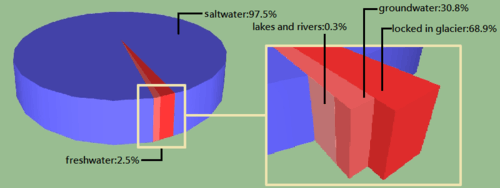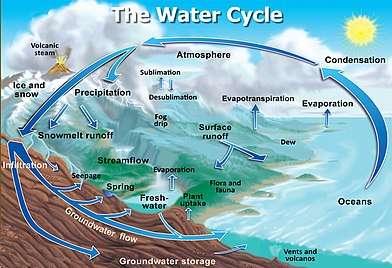Hydrosphere
The hydrosphere (from Greek ὕδωρ hydōr, "water"[1] and σφαῖρα sphaira, "sphere"[2]) is the combined mass of water found on, under, and above the surface of a planet, minor planet or natural satellite. Although Earth's hydrosphere has been around for about 4 billion years,[3][4] it continues to change in shape. This is caused by seafloor spreading and continental drift, which rearranges the land and ocean.[5]

It has been estimated that there are 1,386 million cubic kilometres (333,000,000 cubic miles) of water on Earth.[6] This includes water in liquid and frozen forms in groundwater, oceans, lakes and streams. Saltwater accounts for 97.5% of this amount, whereas fresh water accounts for only 2.5%. Of this fresh water, 68.9% is in the form of ice and permanent snow cover in the Arctic, the Antarctic and mountain glaciers; 30.8% is in the form of fresh groundwater; and only 0.3% of the fresh water on Earth is in easily accessible lakes, reservoirs and river systems.[6]
The total mass of Earth's hydrosphere is about 1.4 × 1018 tonnes, which is about 0.023% of Earth's total mass. At any given time, about 20 × 1012 tonnes of this is in the form of water vapor in the Earth's atmosphere (for practical purposes, 1 cubic meter of water weighs one tonne). Approximately 71% of Earth's surface, an area of some 361 million square kilometers (139.5 million square miles), is covered by ocean. The average salinity of Earth's oceans is about 35 grams of salt per kilogram of sea water (3.5%).[7]
Water cycle

The water cycle refers to the transfer of water from one state or reservoir to another. Reservoirs include atmospheric moisture (snow, rain and clouds), streams, oceans, rivers, lakes, groundwater, subterranean aquifers, polar ice caps and saturated soil. Solar energy, in the form of heat and light (insolation), and gravity cause the transfer from one state to another over periods from hours to thousands of years. Most evaporation comes from the oceans and is returned to the earth as snow or rain.[8]:27 Sublimation refers to evaporation from snow and ice. Transpiration refers to the expiration of water through the minute pores or stomata of trees. Evapotranspiration is the term used by hydrologists in reference to the three processes together, transpiration, sublimation and evaporation.[8]
Marq de Villiers has described the hydrosphere as a closed system in which water exists. The hydrosphere is intricate, complex, interdependent, all-pervading and stable and "seems purpose-built for regulating life."[8]:26 De Villiers claimed that, "On earth, the total amount of water has almost certainly not changed since geological times: what we had then we still have. Water can be polluted, abused, and misused but it is neither created nor destroyed, it only migrates. There is no evidence that water vapor escapes into space."[8]:26
"Every year the turnover of water on Earth involves 577,000 km3 of water. This is water that evaporates from the oceanic surface (502,800 km3) and from land (74,200 km3). The same amount of water falls as atmospheric precipitation, 458,000 km3 on the ocean and 119,000 km3 on land. The difference between precipitation and evaporation from the land surface (119,000 - 74,200 = 44,800 km3/year) represents the total runoff of the Earth's rivers (42,700 km3/year) and direct groundwater runoff to the ocean (2100 km3/year). These are the principal sources of fresh water to support life necessities and man's economic activities."[6]
Water is a basic necessity of life. Since 2/3 of the Earth is covered by water, the Earth is also called the blue planet and the watery planet.[notes 1] The hydrosphere plays an important role in the existence of the atmosphere in its present form. Oceans are important in this regard. When the Earth was formed it had only a very thin atmosphere rich in hydrogen and helium similar to the present atmosphere of Mercury. Later the gases hydrogen and helium were expelled from the atmosphere. The gases and water vapor released as the Earth cooled became its present atmosphere. Other gases and water vapor released by volcanoes also entered the atmosphere. As the Earth cooled the water vapor in the atmosphere condensed and fell as rain. The atmosphere cooled further as atmospheric carbon dioxide dissolved in to rain water. In turn this further caused the water vapor to condense and fall as rain. This rain water filled the depressions on the Earth's surface and formed the oceans. It is estimated that this occurred about 4000 million years ago. The first life forms began in the oceans. These organisms did not breathe oxygen. Later, when cyanobacteria evolved, the process of conversion of carbon dioxide into food and oxygen began. As a result, Earth's atmosphere has a distinctly different composition from that of other planets and allowed for life to evolve on Earth.
Recharging reservoirs
According to Igor A. Shiklomanov, it takes 2500 years for the complete recharge and replenishment of oceanic waters, 10,000 years for permafrost and ice, 1500 years for deep groundwater and mountainous glaciers, 17 years in lakes and 16 days in rivers.[6]
Specific fresh water availability
"Specific water availability is the residual (after use) per capita quantity of fresh water."[6] Fresh water resources are unevenly distributed in terms of space and time and can go from floods to water shortages within months in the same area. In 1998 76% of the total population had a specific water availability of less than 5.0 thousand m³ per year per capita. Already by 1998, 35% of the global population suffered "very low or catastrophically low water supplies" and Shiklomanov predicted that the situation would deteriorate in the twenty-first century with "most of the Earth's population will be living under the conditions of low or catastrophically low water supply" by 2025. Only 2.5% of the water in the hydrosphere is fresh water and only 0.25% of that water is accessible for our use.
Human impact on the hydrosphere
The activities of modern humans has drastic effects on the hydrosphere. For instance, water diversion, human development, and pollution all affect the hydrosphere and natural processes within. Humans are withdrawing water from aquifers and diverting rivers at an unprecedented rate. The Ogallala Aquifer is used for agriculture in the United States and if the aquifer goes dry, more than $20 billion worth of food and fiber will vanish from the world's markets.[9] The aquifer is being depleted so much faster than it is replenished and eventually, the aquifer will run dry. Additionally, only 1/3 of rivers are free-flowing due to the extensive use of dams, levees, hydropower and habitat degradation. Carrington, Damian (May 8, 2019). "Only a third of world's great rivers remain free flowing, analysis finds". The Guardian. Retrieved March 26, 2020. Other ways humans impact the hydrosphere include eutrophication, acid rain, and ocean acidification.
See also
- Biosphere
- Climate system
- Cryosphere
- Earth's atmosphere
- Lithosphere
- Ocean
- Pedosphere
- Water cycle
Notes
- According to planetary geologist, Ronald Greeley, "Water is very common in the outer solar system." Europa holds more water than earth's oceans.
References
- ὕδωρ, Henry George Liddell, Robert Scott, A Greek-English Lexicon, on Perseus
- σφαῖρα, Henry George Liddell, Robert Scott, A Greek-English Lexicon, on Perseus
- Encyclopædia Britannica, Hydrosphere: https://www.britannica.com/science/hydrosphere/Origin-and-evolution-of-the-hydrosphere
- Albarède, Francis; Blichert-Toft, Janne (November 2007). "The split fate of the early Earth, Mars, Venus, and Moon". Comptes Rendus Geoscience. 339 (14–15): 917–927. Bibcode:2007CRGeo.339..917A. doi:10.1016/j.crte.2007.09.006. Retrieved March 26, 2020.
High d18O in ~4.4-Ga old zircons from Jack Hills (western Australia) strongly indicates the presence of material altered under low-or medium-temperature hydrous conditions in the source of their parent granites and is considered as strong evidence for the early presence of a hydrosphere
- "Our Changing Planet: an Introduction to Earth System Science and Global Environmental Change." Our Changing Planet: an Introduction to Earth System Science and Global Environmental Change, by Fred T. Mackenzie, 2nd ed., Pearson Education, 2011, pp. 88–91.
- World Water Resources: A New Appraisal and Assessment for the 21st Century (Report). UNESCO. 1998. Archived from the original on 27 September 2013. Retrieved 13 June 2013.
- Kennish, Michael J. (2001). Practical handbook of marine science. Marine science series (3rd ed.). CRC Press. p. 35. ISBN 0-8493-2391-6.
- Marq de Villiers (2003). Water: The Fate of Our Most Precious Resource (2 ed.). Toronto, Ontario: McClelland & Stewart. p. 453. ISBN 978-0-7710-2641-6. OCLC 43365804., revised 2003|Governor General's Award (1999)
- Braxton, Jane (March 1, 2009). "The Ogallala Aquifer: Saving a Vital U.S. Water Source". Scientific American. doi:10.1038/scientificamericanearth0309-32. Retrieved March 26, 2020.
